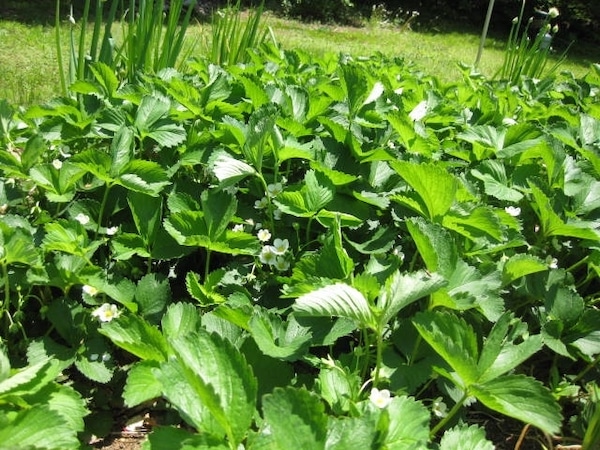Updated: November 18, 2020
I have so many flowers on my strawberry plants that it has me dreaming about all the ways I’m going to eat those berries.
I’m going to put them in my cereal. I’m going to make chocolate covered strawberries. I’m going to try arugula and strawberry salad and, of course, I’m going to spoil myself with strawberry shortcake.
The strawberry plants look very healthy. They’re a dark shade of green and so thick that the weeds can’t get enough light to grow. The only problem is that I’m counting my strawberries before they are ripe. So many things can still go wrong.
It’s the time of year in my area when things look great in the garden and it’s easy to forget that trouble can be just around the corner.
It’s much easier and better for your plants to pull weeds BEFORE they get too big.
— Suburban Hobby Farmer
The weather is warm. There’s plenty of rain. The plants look healthy. The plant eating bugs and other pests haven’t started in earnest.
This is the point when I’m sometimes not as vigilant as I should be. It’s very tempting just to sit back and enjoy the garden.
Everything is going fine. Then one day you take a walk through the garden and are surprised to see the lettuce has been mowed to the ground by a rabbit or worse a ground hog.
Or the new beet seedlings that sprouted just fine after you planted them have dried up because you didn’t water in time.
Or there’s a freak thunder storm with hail (it happened this morning) that knocks out your recently transplanted tomato seedlings.

Let’s take a sec to get the legal words out of the way. This article may contain affiliate links. That means if you click and buy from my partners, I will make a tiny amount of money at no cost to you. This in no way affects my recommendations.
Six things you should be doing now
So when you reach that time in the garden when you are tempted to lay back and let it ride, here are six tips to remind you about what you should be doing:
1. Continue to weed. It’s much easier and better for your plants to pull weeds BEFORE they get too big. At this point, when you pull them, the roots aren’t big enough to disturb your plants. Plus, the weeds haven’t developed seeds yet.
2. Top dress with compost or mulch. This will help with tip number one. Mulch will reduce the number of weeds.
It will also help the soil stay moist when the weather turns hotter and drier.
If you top dress with compost now, the nutrients will be available to the plants when they begin to develop fruit later.
3. Stay vigilant against pests. This is the time when varmints strike. If you have a vulnerable spot in your fence, fix it.
If your apples have just formed, put footies on them now, before curculio or other pests strike.
Buy netting to protect your strawberries or blueberries against the animals that want a free lunch, so you’ll have it in place when the berries ripen.
4. Succession plant. Plant some this week … some in two weeks … some in four weeks. This will help spread the risk of trouble and protect against losing your entire crop.
It also spreads out the harvest so you don’t have too much all at once.
Related: My Plan for Dealing with Mold on Strawberries
5. Keep seedlings in reserve when transplanting outside. Always have good seedlings as backups in case the first transplanting doesn’t work out the way you’ve planned.
This is why you should start your seedlings indoors in waves (succession planting indoors).
When the first group comes of age too soon to plant or something happens to the first wave, you’ll have backups that are ready to go.
6. Purchase seeds for your fall garden. I know it’s sometimes hard to plan ahead, but now is the time to decide what you will be growing in the fall. Otherwise, the seeds you want may be hard to find later in the year.
Related articles you might enjoy:
- Transplanting Strawberries, How to Take Advantage of Daughter Plants
- Using Comfrey Mulch for Strawberries
- When to Start Seedlings Indoors
Suburban Hobby Farmer is a participant in the Amazon Services LLC Associates Program, an affiliate advertising program designed to provide a means for sites to earn advertising fees by advertising and linking to amazon.com.